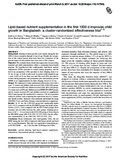Lipid-based nutrient supplementation in the first 1000 d improves child growth in Bangladesh: a cluster-randomized effectiveness trial

View/Open
Date
2017-03-18Publisher
© 2017 American Journal of Clinical NutritionAuthor
Dewey, Kathryn GMridha, Malay K
Matias, Susana L
Arnold, Charles D
Cummins, Joseph R
Khan, Md Showkat Ali
Maalouf-Manasseh, Zeina
Siddiqui, Zakia
Ullah, Md Barkat
Vosti, Stephen A
Metadata
Show full item recordCitation
Dewey, K. G., Mridha, M. K., Matias, S. L., Arnold, C. D., Cummins, J. R., Khan, M. S. A., … Vosti, S. A. (2017). Lipid-based nutrient supplementation in the first 1000 d improves child growth in Bangladesh: a cluster- randomized effectiveness trial. American Journal of Clinical Nutrition, 105(4), 944–957. https://doi.org/10.3945/ajcn.116.147942Abstract
Background: Stunting in linear growth occurs mainly during the first
1000 d, from conception through 24 mo of age. Despite the recognition
of this critical period, there have been few evaluations of the
growth impact of interventions that cover most of this window.
Objective: We evaluated home fortification approaches for preventing
maternal and child undernutrition within a community-based health
program. We hypothesized that small-quantity lipid-based nutrient
supplements (LNSs) provided to women during pregnancy and the
first 6 mo postpartum, LNSs provided to their offspring from 6 to
24 mo of age, or both would result in greater child length-for-age
z score (LAZ) at 24 mo than iron and folic acid (IFA) provided to
women during pregnancy and postpartum plus micronutrient powder
(MNP) or no supplementation for their offspring from 6 to 24 mo.
Design: We conducted a cluster-randomized effectiveness trial with 4
arms: 1) women and children both received LNSs (LNS-LNS group),
2) women received IFA and children received LNSs (IFA-LNS group),
3) women received IFA and children received MNP (IFA-MNP group),
and 4) women received IFA and children received no supplements
(IFA-Control group). We enrolled 4011 women at #20 wk of gestation
within 64 clusters, each comprising the supervision area of a community
health worker. Analyses were primarily performed by using
ANCOVA F tests and Tukey-Kramer–corrected pairwise comparisons.
Results: At 24 mo, the LNS-LNS group had significantly higher
LAZ (+0.13 compared with the IFA-MNP group) and head circumference
(+0.15 z score compared with the IFA-Control group); these
outcomes did not differ between the other groups. Stunting prevalence
(LAZ ,22) was lower in the LNS-LNS group at 18 mo than in
the IFA-MNP group (OR: 0.70; 95% CI: 0.53, 0.92), but the difference
diminished by 24 mo (OR: 0.81; 95% CI: 0.63, 1.04).
Conclusion: Home fortification with small-quantity LNSs, but not
MNP, during the first 1000 d improved child linear growth and head
size in rural Bangladesh. This trial was registered at clinicaltrials.gov
as NCT01715038. Am J Clin Nutr doi: 10.3945/ajcn.116.147942.
